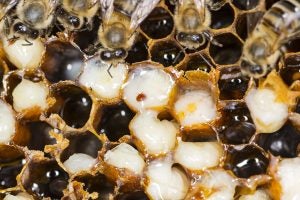Bees. No doubt you have heard or read the statements: “Bees pollinate 1/3 of our food,” or “Without bees we would go hungry.” I would argue that, at least technically, it just ain’t so. Bees are important, no doubt about that. But without their pollination efforts, the world would still have plenty of food. Following is a breakdown of where our calories come from according to the Food and Agriculture Organization of the United Nations.
Humans get approximately 50 percent of their calories from directly eating grains. Wheat supplies 18 percent of calories, rice 19 percent, corn 5 percent, and other grains — such as sorghum, millet, rye and barley — make up the rest. And a lot of grains go into meat, milk, and eggs, which account for 16 percent of world calories. Vegetable oils from soybeans, canola, safflower, sunflowers, etc., provide 10 percent of calories. Pulses — peas, beans, lentils, chickpeas, etc. — provide 2 percent. Alcohol, made mostly from grains and grapes, also provides 2 percent. None of the foregoing crops require pollinators.

Starchy roots supply 5 percent of world calories. Cassava, a starchy root that is a staple in the African savanna, is propagated from tuber cuttings as are yams and potatoes. Sugar provides about 8 percent of calories. Sugar beets benefit from insect pollinators to produce seed, while sugarcane is reproduced vegetatively from cuttings.
Then we get to vegetables and fruits, each supplying 3 percent of world calories. The vegetables we eat don’t require pollination (except tomatoes, which are technically a fruit), but producing seed from which the veggies are grown requires pollinators. Most fruits and nuts require pollinators in order to get a good crop, but wind is also a pollinator. Same goes for melons and berries.
So the truth is, we could get by without insect pollination, but some fruits and vegetables could get scarce and expensive, and our diet could get a little boring. But no way is 1/3 of our food supply dependent on bees.
The other common point made about honeybees spread in the press is that they are declining, with losses as high as 30 percent or more each year. While it is true that beekeepers have suffered more than normal losses the past several winters, the losses are often made up over the summer — though at extra cost — and worldwide, honeybee hive numbers have never lost upward momentum.
A lot of research has been done on what causes Colony Collapse Disorder (CCD) since 2006, when beekeepers first started reporting excessive hive collapse of 30 percent or more during the winter and spring. Beekeepers expect to lose 10 percent of their hives each year, but several years of excessive losses followed the 2006 collapse. The affected hives often have a queen and plenty of food, maybe a few nurse bees, but no worker bees and no clues to their disappearance. Colony collapse is not a new phenomenon: It comes and goes and is as old as beekeeping, but has gone by other names. But the severity of the losses in the United States and Europe the past 15 years has been cause for concern.
Some researchers and environmental organizations lay the blame for CCD on neonicotinide insecticides, also called neonics. These insecticides are chemically similar to nicotine and are neuro-active (brain-affecting). They are more toxic to insects than to birds or mammals, unlike the organophosphates and carbamate insecticides they replace. They are systemic when applied to seeds or leaves, spreading throughout the plant, and are especially effective against sucking insects such as aphids. They are very widely used as seed treatments because they kill wireworms or any other soil insect that eats a seed. When the seeds germinate the insecticide moves with the growing tissue and is effective against sucking insects through the early stages of growth. By the time flowers are produced and bees are feeding on the nectar and pollen, the chemical is too dilute to harm the bees. The experience of beekeepers in Canada proves this point. Canadian farmers grow 19 million acres of canola yearly. Canola doesn’t need bees to pollinate, but beekeepers love to place their hives close to canola fields because bees working canola flowers produce lots of honey. Most canola seed is treated with neonics. A large-scale field experiment by researchers in Canada in which bee hives were exposed to fields of canola found that “colonies were vigorous during and after the exposure period.”

So what is killing the bees? Many things can affect colony health. Beekeepers constantly fight a host of parasites and pathogens, with the worst being a tiny mite that sucks the hemolymph (bee blood) from the bee’s body and can vector viruses into the bee colony. Called the varroa destructor mite, it has plagued U.S. beekeepers since its introduction in the late 1980s. It is a worldwide problem; with the exception of Australia, which has (so far) avoided its importation. Beekeepers must carefully use insecticides and fungicides in their hives to control this mite and other parasites and pathogens that can destroy a hive.
Some studies have blamed neonics for CCD, but peer reviewers claim the experimental methods used don’t represent the “real world.” Other studies have exonerated neonics, and those studies are backed up by the Australian experience, whose farmers use neonics on many crops where bees forage while beekeepers have little problem with CCD.
This class of pesticides includes very important tools for farmers, especially when used as seed treatments. Neonics should not be banned, as they have been in Europe, without undeniable proof that they are causing irreparable harm to bees.
Jack DeWitt is a farmer-agronomist with farming experience that spans the decades since the end of horse farming to the age of GPS and precision farming. He recounts all and predicts how we can have a future world with abundant food in his book “World Food Unlimited.” A version of this article was republished from Agri-Times Northwest with permission.



